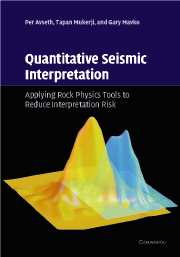Book contents
- Frontmatter
- Contents
- Preface
- 1 Introduction to rock physics
- 2 Rock physics interpretation of texture, lithology and compaction
- 3 Statistical rock physics: Combining rock physics, information theory, and statistics to reduce uncertainty
- 4 Common techniques for quantitative seismic interpretation
- 5 Case studies: Lithology and pore-fluid prediction from seismic data
- 6 Workflows and guidelines
- 7 Hands-on
- References
- Index
- Plate section
4 - Common techniques for quantitative seismic interpretation
Published online by Cambridge University Press: 27 January 2010
- Frontmatter
- Contents
- Preface
- 1 Introduction to rock physics
- 2 Rock physics interpretation of texture, lithology and compaction
- 3 Statistical rock physics: Combining rock physics, information theory, and statistics to reduce uncertainty
- 4 Common techniques for quantitative seismic interpretation
- 5 Case studies: Lithology and pore-fluid prediction from seismic data
- 6 Workflows and guidelines
- 7 Hands-on
- References
- Index
- Plate section
Summary
There are no facts, only interpretations.
Friedrich NietzscheIntroduction
Conventional seismic interpretation implies picking and tracking laterally consistent seismic reflectors for the purpose of mapping geologic structures, stratigraphy and reservoir architecture. The ultimate goal is to detect hydrocarbon accumulations, delineate their extent, and calculate their volumes. Conventional seismic interpretation is an art that requires skill and thorough experience in geology and geophysics.
Traditionally, seismic interpretation has been essentially qualitative. The geometrical expression of seismic reflectors is thoroughly mapped in space and traveltime, but little emphasis is put on the physical understanding of seismic amplitude variations. In the last few decades, however, seismic interpreters have put increasing emphasis on more quantitative techniques for seismic interpretation, as these can validate hydrocarbon anomalies and give additional information during prospect evaluation and reservoir characterization. The most important of these techniques include post-stack amplitude analysis (bright-spot and dim-spot analysis), offset-dependent amplitude analysis (AVO analysis), acoustic and elastic impedance inversion, and forward seismic modeling.
These techniques, if used properly, open up new doors for the seismic interpreter. The seismic amplitudes, representing primarily contrasts in elastic properties between individual layers, contain information about lithology, porosity, pore-fluid type and saturation, as well as pore pressure – information that cannot be gained from conventional seismic interpretation.
Qualitative seismic amplitude interpretation
Until a few decades ago, it would be common for seismic interpreters to roll out their several-meters-long paper sections with seismic data down the hallway, go down on their knees, and use their colored pencils to interpret the horizons of interest in order to map geologic bodies.
- Type
- Chapter
- Information
- Quantitative Seismic InterpretationApplying Rock Physics Tools to Reduce Interpretation Risk, pp. 168 - 257Publisher: Cambridge University PressPrint publication year: 2005
- 19
- Cited by



